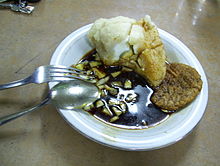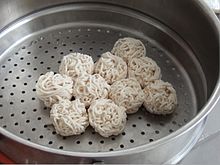Empek-empek
Pempek, mpek-mpek or empek-empek is a savoury fishcake delicacy from Palembang,[1] Indonesia, made of fish and tapioca. Pempek is served with yellow noodles and a dark, rich sweet and sour sauce called kuah cuka or kuah cuko (lit. vinegar sauce), or "cuko".
Pempek is the best-known of Palembang's dishes.
[2] Its origin is undoubtedly Palembang. However, the history behind the creation of this savoury dish is unclear. According to local tradition, around the 16th century there was an old
Chinese immigrant who lived near the
Musi river. He noticed an abundance of fish caught by the local fishermen. In the
Sumatran tropical climate, before the invention of
refrigeration technology, most of these unsold leftover fish decayed and were wasted. The indigenous people, however had limited knowledge and techniques for processing fish. During that period, most of the indigenous people simply grilled, fried or boiled their fish instead of adding other ingredients to make new dishes. The old Chinese man mixed in some
tapioca and other spices, which he then sold around the village on his cart. The people referred to this old man as 'pek-apek, where
apek is a Chinese slang word to call an old man. The food is known today as empek-empek or pempek.
Another theory suggests that pempek was a Palembang adaptation of Southern Chinese ngo hiang or kekkian (fish slice) as a surimi (魚漿, yújiāng) based food. But instead of being served in soup or plainly fried, pempek is notable for its spicy palm sugar-vinegar based sauce.
This fishcake dough can be made into various shapes and forms with additional ingredients. Just like pasta the shapes have their own distinctive names, although all are made from the same dough. There are many varieties of pempek,[5] pempek variants are:
- Pempek kapal selam: (Indonesian: submarine pempek), which is made from a chicken egg wrapped within the pempek dough and then deep-fried. The shape is similar to Chinese dumplings but larger in size. According to food science and technology scientist, thepempek kapal selam, with egg addition, is rich in protein, fat, vitamin a, mineral, and carbohydrate content, is the most nutritious variety.[6] The name derived from the shape of pempek that resembles submersible midget submarine.

Pempek kapal selam and
kulit.
- Pempek telur kecil: (Indonesian: small egg pempek), filled with egg similar to pempek kapal selam, but smaller in size.
- Pempek lenjer: long cylindrical pempek, its shape is similar to sausages.

Pempek Keriting (Curly pempek)
- Pempek keriting: (Indonesian: curly pempek), the dough is made into small noodle ball. This similar process also applied to produce white krupuk.
- Pempek pistel: the shape and size is similar to pempek telur kecil, but filled with minced youngpapaya instead.
- Pempek kulit: (Indonesian: skin pempek), fish-skin pempek, the dough is mixed with minced fish skin, as the result it has stronger fishy aroma and darker color.
- Pempek adaan: ball shaped pempek.
- Pempek tahu: tofu sliced and filled with pempek dough.
- Pempek model (Model Iwak): tofu wrapped inside pempek dough. Similar to pempek kapal selam, but egg is replaced with tofu.
The pempek fishcake can be used as a base ingredient of other dishes. The unfried cylindrical pempek lenjer is often cut and added as a mixture to the following dishes:
- Celimpungan: small pempek balls cooked in spicy coconut milk, served with chilli and sprinkled with bawang goreng (fried shallots).
- Laksan: often referred to as Palembang style pempek in laksa soup, sliced pempek fishcake served in coconut milk based soup.
- Lenggang: omelette with mixture of sliced pempek fishcake, also served in kuah cuko.
- Tekwan: chopped pempek fishcake soup with jicama, mushroom and fishballs.

